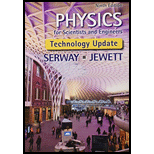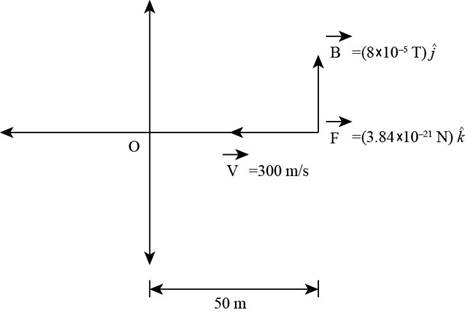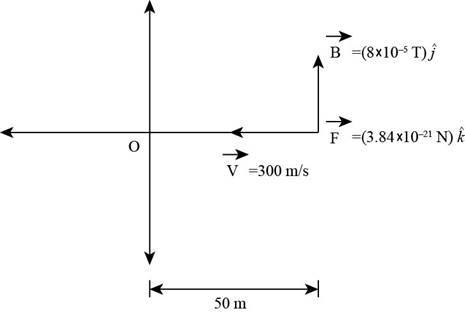
Concept explainers
In a long, .straight, vertical lightning stroke, electrons move downward and positive ions move upward and constitute a current of magnitude 20.0 kA. At a location 50.0 m east of the middle of the stroke, a free electron drifts through the air toward the west with a speed of 300 m/s. (a) Make a sketch showing the various vectors involved. Ignore the effect of the Earth's magnetic field. (b) Find the vector force the lightning stroke exerts on the electron. (c) Find the radius of the electron’s path. (d) Is it a good approximation to model the electron as moving in a uniform field? Explain your answer. (e) If it does not collide with any obstacles, how many revolutions will the electron complete during the 60.0-µs duration of the lightning stroke?
(a)
To draw: The various vectors involved to represent the lightning stroke of the electron and the positive ions.
Answer to Problem 30.16P
The various vectors involved to represent the lightning stroke of the electron and the positive ions as shown below,

Explanation of Solution
Given info: The electrons move downward and the positive ions move upwards. The magnitude of the uniform current is
According to the Ampere’s right hand thumb rule, the index finger represents the direction of the velocity vector
Write the expression for the magnetic field.
Here,
Substitute
Write the expression for the direction of the magnetic field according to the ampere’s law of the magnetic field.
Write the expression for the velocity vector pointed towards the west.
Write the expression for the force vector on the electron,
Here,
Substitute
From the result of the force vector, field vector and velocity vector the as shown below,

Figure (1)
(b)
The vector force lightning stroke exert on the electron.
Answer to Problem 30.16P
The vector force lightning stroke exert on the electron is
Explanation of Solution
Given info: The electrons move downward and the positive ions move upwards. The magnitude of the uniform current is
From the part (a), the vector force on the electron.
Conclusion:
Therefore, the vector force lightning stroke exert on the electron is
(c)
The radius of the electron path.
Answer to Problem 30.16P
The radius of the electron path is
Explanation of Solution
Given info: The electrons move downward and the positive ions move upwards. The magnitude of the uniform current is
Write the expression for the radius of the electron path.
Here,
Substitute
Conclusion:
Therefore, the radius of the electron path is
(d)
Whether it is a good approximation to model the electron as moving in a uniform field.
Answer to Problem 30.16P
The electron was not moving in a uniform field cause of the magnetic field is varies from the location of the lightning stroke.
Explanation of Solution
Given info: The electrons move downward and the positive ions move upwards. The magnitude of the uniform current is
From the figure (1) of the part (a), the magnitude of the magnetic field is varies with the distance of the light stroke towards the positive
Conclusion:
Therefore, the electron was not moving in a uniform field cause of the magnetic field is varies from the location of the lightning stroke.
(e)
The number of the revolutions will the electron complete during the
Answer to Problem 30.16P
The number of the revolutions will the electron complete during
Explanation of Solution
Given info: The electrons move downward and the positive ions move upwards. The magnitude of the uniform current is
From the part (c) the radius of the electron path,
Write the expression for the number of the revolution complete by the electron.
Here,
Substitute
Conclusion:
Therefore, the number of the revolutions will the electron complete during
Want to see more full solutions like this?
Chapter 30 Solutions
Bundle: Physics for Scientists and Engineers, Technology Update, 9th Loose-leaf Version + WebAssign Printed Access Card, Multi-Term
- Which of the following is part of the interior of the Sun? photosphere the corona sunspots radiation zonearrow_forwardMost craters on the surface of the Moon are believed to be caused by which of the following? faults asteroids volcanoes meteoroidsarrow_forwardAn object is subjected to a friction force with magnitude 5.49 N, which acts against the object's velocity. What is the work (in J) needed to move the object at constant speed for the following routes? y (m) C B (5.00, 5.00) A x (m) © (a) the purple path O to A followed by a return purple path to O ] (b) the purple path O to C followed by a return blue path to O ] (c) the blue path O to C followed by a return blue path to O ] (d) Each of your three answers should be nonzero. What is the significance of this observation? ○ The force of friction is a conservative force. ○ The force of friction is a nonconservative force.arrow_forward
- A block of mass m = 2.50 kg is pushed d = 2.30 m along a frictionless horizontal table by a constant applied force of magnitude F = 10.0 N directed at an angle 25.0° below the horizontal as shown in the figure below. m (a) Determine the work done by the applied force. ] (b) Determine the work done by the normal force exerted by the table. ] (c) Determine the work done by the force of gravity. ] (d) Determine the work done by the net force on the block. ]arrow_forwardA man pushing a crate of mass m = 92.0 kg at a speed of v = 0.845 m/s encounters a rough horizontal surface of length = 0.65 m as in the figure below. If the coefficient of kinetic friction between the crate and rough surface is 0.357 and he exerts a constant horizontal force of 294 N on the crate. e (a) Find the magnitude and direction of the net force on the crate while it is on the rough surface. magnitude direction ---Select--- N (b) Find the net work done on the crate while it is on the rough surface. ] (c) Find the speed of the crate when it reaches the end of the rough surface. m/sarrow_forwardTwo blocks, A and B (with mass 45 kg and 120 kg, respectively), are connected by a string, as shown in the figure below. The pulley is frictionless and of negligible mass. The coefficient of kinetic friction between block A and the incline is μk = 0.26. Determine the change in the kinetic energy of block A as it moves from to, a distance of 15 m up the incline (and block B drops downward a distance of 15 m) if the system starts from rest. × J 37° Barrow_forward
- You are working for the Highway Department. In mountainous regions, highways sometimes include a runaway truck ramp, and you are asked to help with the design of such a ramp. A runaway truck ramp is often a lane of gravel adjacent to a long downhill section of roadway where trucks with failing brakes may need assistance to stop. Working with your supervisor, you develop a worst-case scenario: a truck with a mass of 6.00 × 104 kg enters a runaway truck lane traveling at 34.1 m/s. Assume that the maximum constant value for safe acceleration of the truck is -5.00 m/s². Any higher magnitude of acceleration increases the likelihood that semi-trailer rigs could jackknife. Your supervisor asks you to advise her on the required length (in m) of a runaway truck lane on a flat section of ground next to the roadway. marrow_forwardA large cruise ship of mass 6.20 × 107 kg has a speed of 10.2 m/s at some instant. (a) What is the ship's kinetic energy at this time? ] (b) How much work is required to stop it? (Give the work done on the ship. Include the sign of the value in your answer.) ] (c) What is the magnitude of the constant force required to stop it as it undergoes a displacement of 3.10 km? Narrow_forwardA 7.80 g bullet is initially moving at 660 m/s just before it penetrates a block of wood to a depth of 6.20 cm. (a) What is the magnitude of the average frictional force (in N) that is exerted on the bullet while it is moving through the block of wood? Use work and energy considerations to obtain your answer. N (b) Assuming the frictional force is constant, how much time (in s) elapses between the moment the bullet enters the block of wood and the moment it stops moving? Sarrow_forward
- Please don't use Chatgpt will upvote and give handwritten solutionarrow_forwardTwo blocks, A and B (with mass 45 kg and 120 kg, respectively), are connected by a string, as shown in the figure below. The pulley is frictionless and of negligible mass. The coefficient of kinetic friction between block A and the incline is μk = 0.26. Determine the change in the kinetic energy of block A as it moves from to ①, a distance of 15 m up the incline (and block B drops downward a distance of 15 m) if the system starts from rest. ] 37° A © Barrow_forwardA skateboarder with his board can be modeled as a particle of mass 80.0 kg, located at his center of mass. As shown in the figure below, the skateboarder starts from rest in a crouching position at one lip of a half-pipe (point). On his descent, the skateboarder moves without friction so that his center of mass moves through one quarter of a circle of radius 6.20 m. i (a) Find his speed at the bottom of the half-pipe (point Ⓡ). m/s (b) Immediately after passing point Ⓑ, he stands up and raises his arms, lifting his center of mass and essentially "pumping" energy into the system. Next, the skateboarder glides upward with his center of mass moving in a quarter circle of radius 5.71 m, reaching point D. As he passes through point ①, the speed of the skateboarder is 5.37 m/s. How much chemical potential energy in the body of the skateboarder was converted to mechanical energy when he stood up at point Ⓑ? ] (c) How high above point ① does he rise? marrow_forward
 Physics for Scientists and Engineers: Foundations...PhysicsISBN:9781133939146Author:Katz, Debora M.Publisher:Cengage Learning
Physics for Scientists and Engineers: Foundations...PhysicsISBN:9781133939146Author:Katz, Debora M.Publisher:Cengage Learning Physics for Scientists and Engineers, Technology ...PhysicsISBN:9781305116399Author:Raymond A. Serway, John W. JewettPublisher:Cengage Learning
Physics for Scientists and Engineers, Technology ...PhysicsISBN:9781305116399Author:Raymond A. Serway, John W. JewettPublisher:Cengage Learning
 Principles of Physics: A Calculus-Based TextPhysicsISBN:9781133104261Author:Raymond A. Serway, John W. JewettPublisher:Cengage Learning
Principles of Physics: A Calculus-Based TextPhysicsISBN:9781133104261Author:Raymond A. Serway, John W. JewettPublisher:Cengage Learning Glencoe Physics: Principles and Problems, Student...PhysicsISBN:9780078807213Author:Paul W. ZitzewitzPublisher:Glencoe/McGraw-Hill
Glencoe Physics: Principles and Problems, Student...PhysicsISBN:9780078807213Author:Paul W. ZitzewitzPublisher:Glencoe/McGraw-Hill College PhysicsPhysicsISBN:9781305952300Author:Raymond A. Serway, Chris VuillePublisher:Cengage Learning
College PhysicsPhysicsISBN:9781305952300Author:Raymond A. Serway, Chris VuillePublisher:Cengage Learning





